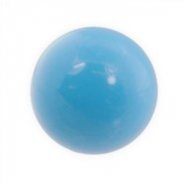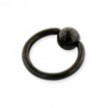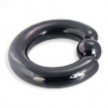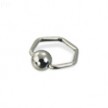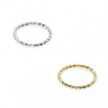Turquoisecaptive bead ball
- -: priced and sold individually
- -: Made In USA
- -: Customization available, contact us.
- Gem Type: Turquoise
| Click on the picture to see a big picture and description of the body jewelry you are interested in. | |||||||||
|---|---|---|---|---|---|---|---|---|---|
|
Black captive bead ring, 14 ga
$7.99
Black captive bead ring, 14 ga
|
Titanium anodized black captive bead ring,...
$11.99
Titanium anodized black captive bead ring, 4 ga
Shown: 1/2" CBR. |
Hexagon captive bead ring, 16 ga
$6.99
Hexagon captive bead ring, 16 ga
Shown; 3/8" captive bead ring. |
14K Gold Twisted Seamless Ring
$25.99
14K Gold Twisted Seamless Ring
|
||||||
CHANGING JEWELRY
After a piercing is healed, jewelry may be changed as desired. It is important to wear jewelry of the same gauge as the original piercing. Too small a gauge and the piercing will shrink around the smaller jewelry; too big and the piercing will require stretching. With some piercings the jewelry must be of a certain design to be comfortable.
If changing jewelry is necessary in a new piercing or before the piercing has healed the change must be continuous to prevent the piercing from shrinking or closing. Contact between the two pieces of jewelry must be securely maintained. In some cases an insertion taper should be used to better facilitate a smooth procedure. For example, when changing rings the ring ends cannot be held together very easily or securely. The concave, gauged end of the taper should be abutted against the existing ring and pushed into the piercing and the new ring inserted in the opposite direction. When changing internally threaded barbells the barbells can easily be held together.
Changing jewelry in a healed piercing is made easier by lubricating the piercing and the new piece of jewelry using a water-based lubricant. Place a small amount of lubricant onto the existing jewelry using a cotton swab. Rotate the jewelry, thoroughly lubricating the piercing. In the case of rings lubricating the piercing can be done after opening the ring, which can be challenging if the ring is slippery. The new jewelry should be soaked in disinfectant solution prior to insertion, if it is not already pre-sterilized.
Externally threaded jewelry requires lubrication to prevent damage to the piercing. The threads can also be covered with orthodontal wax or dipped in hot candle wax. The wax can be removed with rubbing alcohol.
If pliers are used to close or open rings wrap the jaws with surgical tape to prevent scratching the jewelry. Factors which affect how tightly the bead is held in place are how annealed (soft) the ring is, how deeply the bead is bored, and the relationship between the gauge and diameter of the ring. In the case of captive bead rings in small diameters or thicker gauges ring expanding pliers may be required to release the bead. If the gap in the ring is too wide to hold the bead, ring closing pliers are required. Both types of pliers are available through most piercing jewelry and supply retailers. Expanding pliers (also called snap ring or rasary pliers) are sometimes available at hardware stores.
Seamless and attached bead rings should be opened by torquing the ring to maintain ring tension. Captive bead rings should be opened by torquing if the gap in the ring is too small to comfortably insert the jewelry. How much effort is required depends on the hardness of the metal, the gauge and the diameter of the ring. Frequent torquing and bending may warp the ring and eventually weaken the metal to the point of breakage. Annealed jewelry will resist warping a breaking.
Threaded jewelry is most securely tightened using a tissue or gauze to grip the balls. Never use pliers to tighten balls; finger strength should be enough. In the case of internally threaded jewelry using pliers may strip the threads from the ball.
